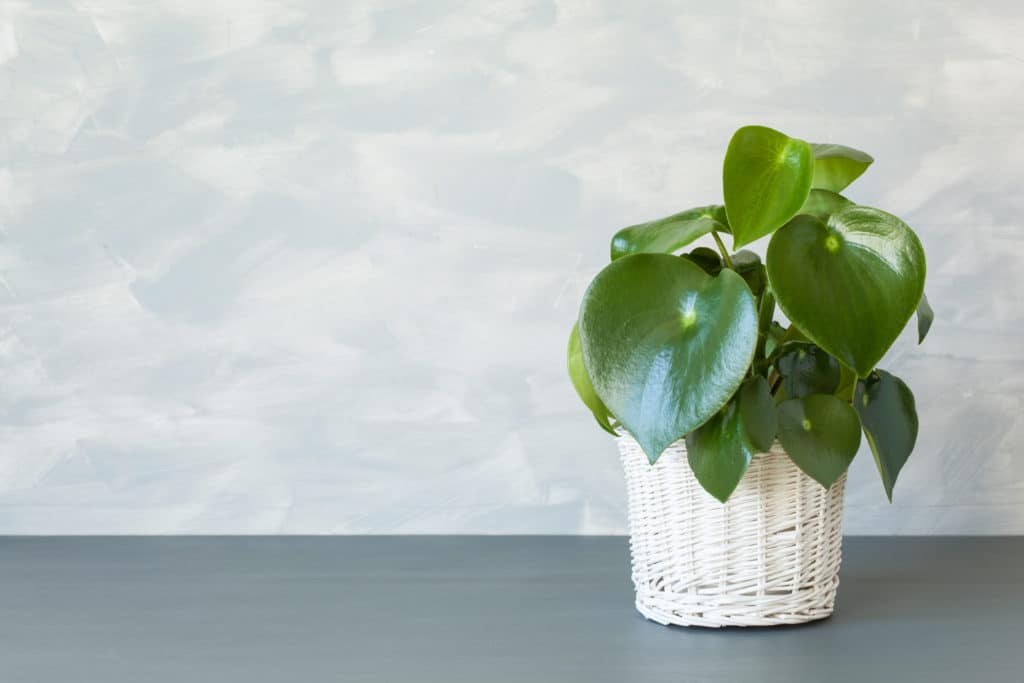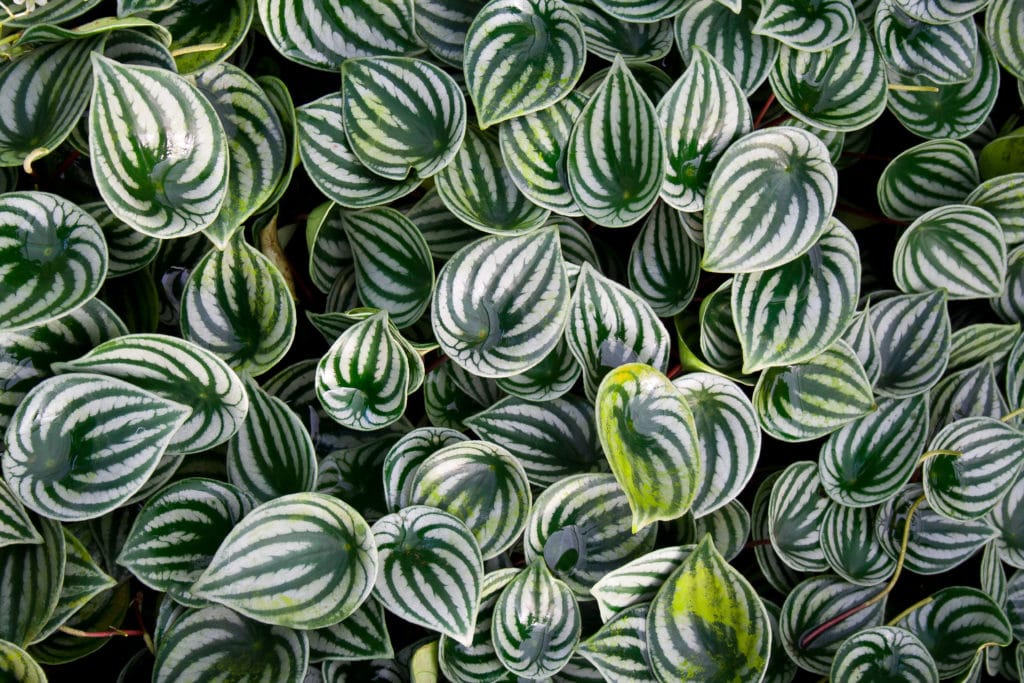
Peperomia is a genus of the Piperaceae family that includes around 200 Peperomia species. They are native to tropical and subtropical regions of North America, South America, Africa, Asia, and Australia.
This diverse genus has many features that make them ideal houseplants for anyone looking to expand their collection!
In this article, we’ll be discussing peperomia care; from planting to maintenance.
About the Peperomia Plant
There is a great variety of peperomia plants, with foliage ranging from plain green to brightly colored and patterned. The leaves are often oval or heart-shaped, and some species have succulent stems.
All peperomias prefer bright indirect light, although a few can tolerate direct sun for short periods. They will do best in moist but well-drained soil that is slightly acidic to neutral.
Peperomias are native to Central America and other tropical and subtropical areas of the world. The majority are compact perennial plants that are grown for their ornamental foliage rather than their blooms, which are modest.
Peperomia propagate easily from stem cuttings taken in the spring or summer. You can also divide older clumps by gently pulling them apart into smaller pieces. Each piece should have at least one leaf and a bit of stem attached. Repot as needed in fresh potting mix, taking care not to disturb the roots. Water regularly, especially during hot weather and drought periods.
Height And Spread
Peperomia plants are tiny and sluggish-growing, with the majority growing no higher than 1 foot (30 cm) tall and just a few reaching 2 feet (60cm). Bushy and trailing types exist, but most peperomias reach a mature spread of only 8-12 inches (20-30 cm). Because of this, they’re ideal houseplants for little areas since they don’t require much maintenance.
Peperomia Care: Planting & Repotting
The best time to plant peperomias is in spring or early summer when temperatures are warm but not too hot (65º – 75ºF). If you plan on bringing your peperomia houseplant outdoors for part of the year, wait until all signs of danger from frost have passed before moving it outside again.
Always acclimate plants gradually by placing them out a few hours each day at first and increasing that time every couple of days so they adjust slowly to their new environment without suffering any stress or shock that can lead to leaf drop or other problems. Do this even if growing these plants in a container.
When potting peperomia, use a well-draining soil mix that is high in organic matter. You can either purchase a commercial potting mix specifically for succulents and cacti, or make your own by blending equal parts of peat moss, perlite, and vermiculite. Add some compost or aged manure to the mix if you want to give your plants an added boost.
Peperomia do not need frequent repotting but should be done every other year or so when they get crowded and their roots start to fill up the pot’s drainage hole. Gently remove the plant from its current pot and loosen all the roots with your fingers before placing it in its new pot. Be sure to make the new pot’s drainage hole just slightly larger than the old one, and place a small amount of non-porous material (like pebbles) in it before filling with soil so water drains out quickly but is able to enter again easily when watering your plant.
Peperomia Care: Watering & Feeding
During hot weather, you should be careful not to over-water peperomia plants as they can get root rot if left wet for too long between waterings; the best way to tell if yours need more or less moisture is by examining their leaves: bright green ones are getting enough moisture while dull greenish or yellowish ones aren’t. If this happens, cut back on watering until the leaves return to their normal color. In winter, when days are shorter and temperatures cooler, you can water your plants less often.
Fertilize peperomia houseplants with a balanced liquid fertilizer (20-20-20) diluted to half strength every other month. You can also side-dress them with organic compost once or twice a year for an added nutrient boost.
Peperomia are generally a pest-free houseplant but may occasionally get aphids, fungus gnat problems, mealybugs, or scale insects. If this happens, use horticultural oil or insecticidal soap to get rid of them.

Watermelon Peperomia
The Watermelon Peperomia (Peperomia argyreia) is a beautiful and unusual peperomia plant that has dark green leaves with silver markings on the top and light green leaves with silver markings on the bottom. It gets its name from the dark pink veins that run through its light green leaves.
This succulent can be grown as a houseplant or outdoors in USDA Zones 11-12. When grown indoors, it prefers bright, indirect light.
Outdoors, it thrives in direct sun to partial shade. It tolerates dry soil but does best when watered regularly.
How Do You Prune Peperomia?
When it comes to trimming peperomia plants, there’s no need to be overly delicate. They take pruning very well, so don’t be afraid to go all out.
Because I appreciate the dainty, compact look of peperomia plants, I’m usually quite ruthless when it comes to trimming them back in order to preserve their attractive appearance.
Aside from looking good, you should also remove any dead growth and yellowing leaves that reveal signs of damage or sickness. Early detection of unhealthy vegetation, its removal, and the prevention of recurrence are critical strategies to maintain your house plant health.
How To Propagate Peperomia
Peperomia plants are easy to grow, and they’re a fantastic method to grow your plant collection or share your lovely plants with friends and family.
Leaf cuttings and stem cuttings are the most common methods for growing peperomia plants.
The method you employ will be determined by the kind of peperomia you have, as well as your own personal taste. One thing to bear in mind is that variegated peperomia types are easier to grow through stem cutting since this will more consistently preserve the leaf pattern.
Propagating Peperomia By Leaf Cuttings
- Arrange your propagation tray or plant pots before they’re needed. Use an equal ratio of potting compost and perlite in the planting mix.
- Ensure your propagation tray and any equipment you employ are clean, if not sterile since the fungal disease is the most common problem that can prevent you from reproducing Peperomia.
- Remove a healthy leaf from the plant. You may remove this from the stem at the bottom, or with a little stem still attached. For this, use sterile scissors or pruning shears.
- You can propagate with whole leaves, but I recommend cutting the leaf in half across its width.
- Ensure that the leaf’s edge is dusted with rooting powder. This will encourage new roots to develop.
- Insert a leaf cutting 1-2 cm into the potting mix using a knife or spoon to make a tiny channel in the medium.
- Cut the foliage with the cut edge of the leaf down into the soil and firmly pack around it to secure it.
- Make sure the potting material is completely wet.
- Cover the cuttings. Use a propagator tray covered with plastic or create a bag over the top of the container.
- At normal indoor room temperature, you should keep the growing plants in bright indirect light.
- To minimize the formation of excessive moisture, replace the cover for a few hours every few days.
- The first thing you may notice is the growth of new roots from the cut edge of the leaf. Then a new shoot appears, and eventually leaves develop.
- When the plants have several new sets of leaves and are growing brightly, they may be potted individually.
- Don’t be rushed to pot your new peperomias right away; as they have shallow root systems and will take some time in a propagation tray.
Propagating Peperomia By Stem Cuttings
This is most effective in the spring when new growth will be at its peak. Here’s a step-by-step walkthrough of how to pot a stem cutting for a peperomia plant.
- Follow the same procedures as for leaf cuttings, only with smaller pots.
- Remove a healthy stem from the plant, keeping at least three pairs of leaves on it. For this, use sterile pair of sharp scissors or pruning shears.
- Remove the bottom pair of leaves and expose a small section of stem.
- Replace the cover on your pot, making sure to press it firmly against the rim. Place a medium-sized potted plant in each container. If you’ve purchased a bare rooted one, this is when you’ll remove any leaves or ties from its stem before dipping its tip into rooting powder.
- Make a tiny hole in the potting mix.
- Drizzle a little water on the soil around the cut to assist it to take root. Place the cutting in a jar with some of its own dirt, then seal it well and store it in an area with temperatures between 40°F and 70°F.
- Make sure the potting media is fully hydrated.
- Follow the same procedure for leaf cutting, but replace “cut it in half” with “leave it whole.”
- Now that you know how to propagate peperomia, the next step is caring for your new plants.
Peperomia Flowers
Peperomia plants aren’t exactly known for their blooms, as they are generally undersized and bushy. Some species have prominent flower spikes, though, with flowers that last for several days.
Flowering is rare. Peperomia are much better known for their beautiful foliage.
Peperomias may also occasionally bloom indoors if they are treated right. They need more light than usual and should be watered regularly during their blooming stage while you prepare them a place outdoors afterward so they can continue growing healthily after flowering has ended.
Caring For Peperomia When Lighting Is Low
Because peperomia plants thrive when given bright indirect light or natural sunlight, their care requirements change quite dramatically from day to night time hours as well as seasonally throughout the year; especially those planted outside where there’s no room for artificial lighting changes (yet).
Are Peperomia Plants Poisonous?
Peperomia plants are completely safe for people and pets. There is no risk of your pet’s coming into contact with or ingesting the plant. You don’t have to be concerned if your pet enjoys nibbling on a leaf here and there because they don’t taste very good.
It’s also great for parents of young children who may put peperomia plants anyplace in their house without risking their kids’ health.
What To Look For When Buying A Peperomia Plant
When selecting a Peperomia, you should ensure that you are receiving a healthy plant, so here are some helpful pointers.
First and foremost, search for plants from a respectable nursery or garden center. Peperomia plants are susceptible to cold damage, so don’t transport or store them incorrectly. The harm may have been done to a plant only recently subjected to incorrect circumstances, but the damage may not yet be visible in its appearance.
Examine the leaves for any discoloration, yellowing, wilting, or physical damage. Look for signs of fungal disease and infestation on both the front and back of the leaves to be sure.
Consider speaking to the shop’s personnel about how long the plants have been in stock and what conditions they’ve been kept in.
Any respectable store should be able to tell you exactly how they’ve been maintained and the transportation procedure for moving them from the grower to the store.
